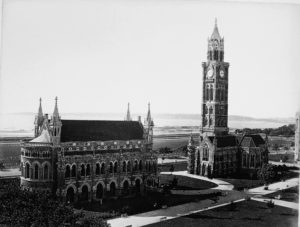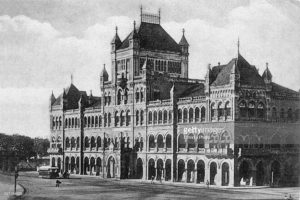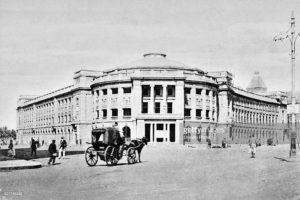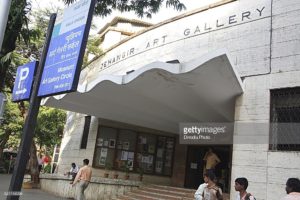————- By Conservation Architect Sanaeya Vandrewala.
In light of the latest inscription of the Victorian Gothic and Art Deco ensemble of Mumbai into the UNESCO World Heritage List and in-keeping with the theme of the previous articles about contribution of Parsis to the growth of India and Bombay as a financial capital listed below are the buildings with either contributions of Philanthropic Parsis or designers of these superlative structures that constitute the World Heritage Site.
By the end of the 17th Century, mercantile communities were encouraged to settle to assist in the rise of Bombay city with assurance of religious freedom, liberty to trade and build homes. At the very beginning of the rise of Bombay, this laid the foundations for the city’s cosmopolitan character and robust financial strength. Among the first communities to settle were Gujarati Banias, Brahmins from Salsette, Parsis, and Armenians. These new communities added to the local population of Kolis, Bhandaris, Agris, Prabhus who were domiciled since the 13th century. By the end of the 18th century, a large population of Parsis had migrated towards Bombay. Parsis had merged with the Indian life and were doing well in various trades and businesses. By 19th century Parsis had become the foremost figures in Bombay establishing the first business houses in the country, they emerged at the local, district and regional level with social and economic gains that were elite based. Thus by the 20th Century Parsis along with other communities they played a major role in making Bombay the richest and the most important industrial and commercial center of India.
Bombay’s historic architecture was built on the foundations of public subscription, entrepreneurship, and philanthropy. Parsi industrialists and entrepreneurs, Hindu and Jain bankers and traders, Muslim and Baghdadi Jewish merchants, Armenians, Salsette Christians and English invested in the future of this emerging city, contributing to the urban landscape during the rise of Bombay.
With the cotton boom in the wake of the American Civil war and the opening up of the Suez Canal, Bombay emerged as a global port city in the 19th century. The demolition of the fort walls in the 1860s created a vast expanse of open space for the once fortified town, giving the British an opportunity to implement an ambitious urban design scheme to position Bombay as Urbs Prima in Indis, ‘the first city of India”, and second only to London in the vast British Empire.
- Convocation Hall, University Complex – Designed by Sir Gilbert Scott this is the most magnificent

An archival image showing the Rajabai Tower and Convocation Hall, Bombay University architectural complex in the city. Sir Cowasjee Jehangir with a hefty donation of Rs. 1 lac to the total budget of Rs. 4 lacs generously contributed to the construction of this beautiful Venetian Neo-Gothic structure standing steadfast since 1874 facing the Oval Maidan.
- Elphinstone College – Designed by Khan Bahadur Mancherjee Murzban in a Neo-Romanesque style meant to house the Government printing press later was inaugurated in 1888 to house the Elphinstone College and State Archives, illustrious alumni including Sir Pherozeshah Mehta, Dadabhai Naoroji, Bhulabhai Desai, Dr. Bhimrao Ambedkar to name a few. A generous amount was collected by public subscription which had a huge sum contributed by Sir Cowasjee Jehangir.

vintage photo-Elphinston College Bombay.
-

vintage photo-Institute of Science Bombay; present day Cawasjee Jehangir Hall Sir Cowasjee Jehangir Hall-National Gallery of Modern Art – Designed by the George Wittet, consulting Architect to Government of India who also designed the Gateway of India and Prince of Wales Museum, the Cowasjee Jehangir Hall stands in the crossing of two major roads whose foundation was laid in 1911 but the building was only opened in 1920 due to the outbreak of the World war in 1914. Designed in Renaissance Revival style the hall is an impressive 100 feet in diameter, housing the National Gallery of Modern Art since 1996 also built with a huge donation from Sir Cowasjee Jehangir.
- Jehangir Art gallery – Built-in 1950’s with funds from Cowasjee Jehangir family, the gallery was first of its

Horizontal Architecture Jehangir Art Gallery Bombay Mumbai Maharashtra India kind in the Kala Ghoda art district. Till date, the pavement plaza outside the gallery provides a platform for budding artists to showcase their art.
5. Regal Cinema – Designed by Charles Steven, son of Frederick William Stevens (famous for designing Victoria Terminus, Municipal Headquarters, Royal Alfred Sailors Home etc) was constructed in 1934 in Reinforced Cement Concrete and was one of the finest theatres in the city of Bombay owned by Globe Theatres Company of K.A. Kooka and F. H .Sidhwa. With interior murals designed by an expatriate Czechoslovakian, Karl Scahara, it is the finest Art Deco examples in the city.


6. Eros Cinema – Funded by entrepreneur Shavak Cambatta and designed by Sohrabji Bhedwar, constructed in the Art Deco style, Eros Cinema was inaugurated in 1938 and was the final word in style and elegance.
7. Several Art Deco buildings of the Backbay Reclamation Scheme completed in 1930’s built on the other side of Oval Maidan opposite the University Complex and along the Marine Drive had Parsi Architectural firms as designers to name a few, Contractor & Kanga, P.C. Dastur, Merwanjee & Bana, Mistri & Bhedwar, K.P. Daver etc and many of them had Shapoorji Pallonji as the Contractors.
To know more about the Mumbai world heritage site, heritage walks are conducted in the heritage precincts for further information or for private, customized tours please contact on email address heritagewalksmumbai@gmail.com or visit our facebook page https://www.facebook.com/MumbaiHeritageWalks/
Bibliography:
http://whc.unesco.org/en/list/1480/ for Mumbai’s inscription
Dwivedi, S and Mehrotra, R (1995) Bombay- The Cities within. Mumbai: Indian Book House Pvt. Ltd.
Dwivedi, S and Mehrotra, R (1999) Fort Walks. Mumbai: Eminence Designs Pvt. Ltd.
Photo credits- Getty Images
Note: Formerly known as Bombay in English, the name of the city was later adapted from its indigenous term in the state language Marathi into English in the year 1995 to be know called as
]]>
Installing the fire in a Fire Temple, a Zoroastrian place of worship is treated like the coronation of a Monarch; in fact the Consecrated Fire itself is addressed as “Padsha” meaning Ruler.
In a Fire Temple the installation of the Aatash Behram is a sacred and long drawn out process which may take anything from one to three years. to begin the process of installing the ‘Aatash Behram’ in the sanctum sanctorum of a Zoroastrian temple, first the various kindling is collected (http://www.mumbaiblogg.com/zoroastrian-cultural-heritage/collection-kindling-for-fire-temple/) , ‘the fire resulting from each kindling is purified by prayers, consecrated and then enthroned in the Sanctum Sanctorum of a Temple with a proper walls and a roof.
Consecration of the fire called ‘Aatash Behram’ (Fire of Knowledge/Victory). (For meaning of Behram see Behram Yasht http://www.mumbaiblogg.com/zoroastrian-zen/avesta-translations/behram-yasht-translation/)
For the consecration, one needs a selected and segregated place in Pavi*,
Fires ignited from kindling collected from **16 different places (see table at the end of this article),

Are each placed in a separate afargan
At the start of the consecration ceremony, each of the 16 fires, are treated as under and each consecrated separately:
On day 1 of the Consecration, A pair of ‘Yaozdathragar***’ undergo the ‘Barashnum’.
The two priests take a small part of the fire from an afargan (a tall, large chalice-shaped vessel covered with a plate on which the fire burns the resultant ashes are stored in the cup of the chalice), containing one of the 16 purified but not yet consecrated fires and place this portion in a separate afargan.
Over this separated portion, the priests perform one Yasna (in the morning) and one Vendidad (at mid-night) along with a ‘Khushnuman’ to a particular Yazad who rules the particular trade from where the fire originates.* (See Table). Thus, on the first three days the Khushnuman the dedication is not to the same Yazad in all 16 cases.
To pray the necessary Yasna it takes the entire hours of the Hawan Geh (morning) and so also to complete the Vendidad takes the entire Hushain Geh (minutes after mid-night to dawn) of each day. Assuming that only one pair of priests was permitted to perform the entire consecration; it would take years (1,128 days approximately) to consecrate an Aatash Behram.
Therefore, pairs of priests pray in tandem so as to complete the process within a plausible time.
The small part of the fire which was segregated from the original afargan and prayed upon is further fed to increase its size.
Simultaneously, the fire in original afargan continues to be fed and kept alive and so also, is the fire which was consecrated on day 1.
On day 2, once again, a small part of the fire from the original afargan is taken and treated separately as done on the previous day.
Now there are three afargan, the original fire, that started on day 1 and the one started on day 2.
Once the Day 2 fire is consecrated, a small portion of the fire consecrated on Day 1 is added to the consecrated fire of day 2. All three afargans continue to be fed and the fires are kept alive.
On Day 3 to Day 30, the process is repeated so that on the 30th day after the 30th bit of fire is consecrated, 29 previously consecrated fires are added to it.
At the end of these thirty days, the process is repeated until the required number of days for the consecration of that particular fire is completed**. (See Table).
For example, the fire from the pyre of a burning corpse is to be consecrated 91 times. So the 30 day process of consecration with the Yasna and Vendidad Ceremonies will be repeated for another thirty days and thereafter for another 28 days, thereby totaling to 3+ 30+30+28= 91.
Each of the 16 fires is so purified and consecrated for the required number of days.** See Table.
All the 16 fires, thus consecrated, are each placed in a separate afargan and each afargan in a separate ‘Pavi’*. All the fires thus consecrated are continued to be fed and kept alive.
DEDICATION OF KHUSHNUMAN TO RELEVANT YAZAD:
As mentioned above, the consecration of fire requires the recitation of Yasna and Vendidad with Khushnuman to the relevant Yazad.
The Khushnuman for the first three days of the consecration are always dedicated to a particular Yazad who rules the particular trade** from where the fire originates.
It is not mandatory to start the process of consecration on the first day of the month; what is necessary that the first three days of consecration of the fire be dedicated to the Yazad who rules the trade-hearth from which the fire was originally lifted.
To understand better, the fire from the pyre is ruled by Hormazd. The first three days of prayers will be dedicated to Hormazd; from the 4th day the Khushnuman will be dedicated to the Yazad whose Roj it is on that day. Assuming the 4th day falls on Zamyaad Roj, the prayer ceremony will be dedicated to the Yazad Zamyaad.
The fire from the Dyer’s hearth is ruled by Boman. So, the prayers on the first three days of purification will be dedicated to Yazad Boman and from the fourth day onward will be dedicated to the Yazad of that particular Roj.
As a further example, the fire from the hearth is ruled by third Yazad, Ardibesht. The prayers for the first three days will be dedicated to Yazad Ardibesht.
Even with the priests praying in Tandem, The consecration of the Aatash Behram easily takes little over a year. The annual feast days like the days of Jashan (feast days) and Ghambhar**** are, therefore, bound to intervene. On such days, the Khushnuman is dedicated to that particular Jashan or the Ghambhar.
All 16 fires thus purified and consecrated are placed one in each afargan, an afargan in each Pavi; so, now we have 16 fires in sixteen afargans in 16 Pavis.
UNITING THE 16 CONSECRATED FIRES TO MAKE THE AATASH BEHRAM:
Uniting these fires must be done on the 1st Ghambhar (five intercalary days added annually to complete the Solar Year).
The unification is made in a huge afargan.
A pair of Yaozdathragar form a paean to seal off any pollution of the consecration,
Then, the Yaozdathgar remove with a ladle, the consecrated pyre fire from its own afargan and place it in the huge afargan.
Similarly, they remove each of the other 15 consecrate fires in order of their consecration (as stated in the Table*) into the huge afargan.
The 16 purified and consecrated fires are thus united in the huge afargan.
The huge afargan is then carried to the Ijashne Gah for the final consecration of the united fire.
CONSECRATION OF THE UNITED FIRE:
For the first three days, The Yasna and Vendidad are prayed over the united fire with Khushnuman to Yazad Sarosh,
From the first day of the immediate next month to the end of the month (Hormazd to Aneran Roj), each day a Yasna and Vendidad are prayed with Khushnuman to the presiding Yazad of that day,
Then, on the next day, which is the last day, another Yasna with Khushnuman to Sarosh is prayed over the united fire and a ritual performed.
The united fire, now consecrated, is then installed in the sanctum sanctorum of the Zoroastrian Temple or ‘enthroned’ (Takht-Nashini).
FIRE TEMPLE AATASH BEHRAM INSTALLATION :
The Daityo Gah (proper place) itself, where the united fire is to be installed, is consecrated for three days prior to the installation by Yasna and Vendidad prayed with Khushnuman to Yazad Sarosh.
The actual installation is a very solemn ceremony conducted with great dignity like any princely coronation.
A Pavi* is drawn alongside the path to the Daityo Gah over which the united consecrated fire will traverse,

The path itself is also broken into several squares by Pavis,
A Pavi is also drawn around the center of the sanctum sanctorum where the united fire will reside.
The head priest leads a procession of all the Yaozdathragar who participated in the consecration,
Two Yaozdathragar carry the united fire,
Each Yaozdathragar in the procession holds either a sword or a mace in his hand,
During its journey to the Daityo Gah, no other Yaozdathragar will step into the same Pavi that is occupied by the united fire and the two priests carrying it,
The united fire is carried to the sanctum sanctorum and installed/enthroned in an afargan standing on a pedestal within the central Pavi,
The fire thus installed is fed with sandalwood and loban and an ‘Aatash ni Nyaesh’ in praise of the fire is prayed.
A Jashan (celebratory prayers) with three Aafringans, is performed in the hall of the temple,
The first Aafringan is prayed with the Khushnuman of Sarosh, the second with Khushnuman of Dahman and the last again, of Sarosh.
The installation/coronation ends with a recitation of the ‘Baaj’*****.
The Aatash Behram is now ready to receive and protect its laity.
* PAVI literally means ‘sacred’ or ‘consecrated’. In Zoroastrian rituals it is a permanently constructed space enclosed and segregated from its surroundings in by a ritual runnels carved in the floor to form a ‘Karsh’ (an intangible curtain of protection against defilement).
**A TABLE TAKEN FROM JIVANJI MODI’S ARTICLE, “THE RELIGIOUS CEREMONIES AND CUSTOMS OF THE PARSEES” (BOMBAY, 1922.)giving the particulars about the different kinds of Fires that are united to form the Sacred Fire of the Aatash Behram and showing the number of the processes of Collection, Purification, and Consecration. |
||||||||||||||||||||||||||||||||||||||||||||||||||||||||||||||||||||||||
|
*** YAOZDATHRAGAR literally meaning ‘purifier’. Yaozdathragar is a Zoroastrian priest who has undergone the rituals of ‘Barashnum’ and ‘Khub’.
****GHAMBHARs are the five intercalary days introduced in the Zoroastrian Calendar, annually, at the close of the year, to complete the 365 days of a Solar Year.
***** BAAJ= Literally means ‘framing’. It also, denotes a ritual silence; also a ritual utterance /prayer which frames an action with the power of the manthra; a high liturgical service . The monthly day (Roj) or the anniversary of death is also called ‘Baaj’.
Bibliography

The Religious Ceremonies and Customs of the Parsees by Jivanji Modi,B.A., PH.D., C.I.E., Fellow of the University of Bombay (1887), Dipl. Litteris et Artibus (Sweden, 1889), Shums -Ul-Ulama (India,1893), Officier D’Acdemie (France, 1898), Officier Publique (France, 1902), Campbell Medalist, B.B.R. Asiatic Society (1918).
]]>Whether it was the ‘C’Remember Mumbaikar’s favourite ride in his favourite BEST Double Decker bus all the way to R C Church.what better way to start this ‘peep into the past’ pictorial journey of Mumbai transport system.
THIS IS HOW IT ALL BEGAN:

BEST, originally in 1873 the “Bombay Tramway Company Limited” (under an Act of the Bombay Presidency), ran Horse-drawn Trams.To run its later electric trams, it set up in 1905, a captive power station at Wadi Bunder with a 4,300 kilowatts (5,800 hp) steam-power generator. This led to it supplying electric power to the city of Bombay; and so was born the’ ‘Bombay Electric Supply & Tramways (BEST) Company’. The BEST bought the assets of the tram-way company for Rs.9, 850,000.

The year 1916 saw the rise of the private enterprise when The Tata PowerBest Gas Lamps before 1907 Company started to supply electricity to the Tram-way in 1916 and by 1925 all power was bought from and supplied by Tatas.

Growing city Bombay already faced rush-hour traffic in these  early years and the Tram-way company introduced Double Decker Trams to ease the problem. None survived to my lifetime, though I recall travelling by trams in my childhood and then by the trolley bus from Gowalia Tank to Grant Road.
early years and the Tram-way company introduced Double Decker Trams to ease the problem. None survived to my lifetime, though I recall travelling by trams in my childhood and then by the trolley bus from Gowalia Tank to Grant Road.

The next avatar of the BEST in 1926 brought Motor-Transport-Buses to Bombay and finally in 1947 it became the ‘Bombay Electric Supply & Tramways (BEST) Company’. Today, since 1995, Mumbaikars know it as “Brihanmumbai Electric Supply & Transport (BEST)”
Before 1865, Bombay had no mass public transport system. An enterprising American company decided to run horse drawn trams in the city and applied

for and was granted a licence; but the “Bombay Omnibus Service” never took off as the fare was exorbitant– service between Malabar Hill and Fort would cost a pass- fare of THIRTY POUNDS a month in the 1860s!
Then, on May 9th, 1874, Bombay saw its first horse-drawn tram at a princely fare of THREE ANNAS (in today’s terms Paisa Fifteen) plying the two routes from Colaba to Pydhonie via Crawford Market and from Bori Bunder to Pydhonie via Kalbadevi. As the travel mode became popular, the fare REDUCED TO TWO ANNAS (6 paisa to an anna). Stearns and Kittredge stabled 900 horses for the Tram Service.
It speaks a lot for the trustful naivety of the fledgling company that NO TICKETS were issued. It soon learnt, and later that year tickets were introduced to discourage ticketless travel. Sounds familiar? Old habits die hard!
The rest of the journey in pictures:











 ‘CERITA’ CNG
‘CERITA’ CNG
 MARVE FERRY of BEST
MARVE FERRY of BEST
Thus, continues the story of the BEST BUSES through the years
]]>